Before You Begin
This tutorial shows you how to create a Top Bottom N parameter to use as a filter in Oracle Analytics.
Background
The Top Bottom N parameter enables selecting a measure to show the highest (top) values to the lowest (bottom) values, for example, the top N (number) products sold, or top N cities by sales. You apply the parameter as a dashboard filter in a visualization.
What Do You Need?
- Access to Oracle Analytics
- Download sample_order_lines.xlsx to your computer
Create a Dataset
In this section, you add the sample_order_lines.xlsx file to Oracle Analytics to create a dataset table.
- Sign in to Oracle Analytics.
- On the Home page, click Create, and then click Dataset.
- In Create Dataset, click Drop data file here or click to browse, select the sample_order_lines.xlsx file, and then click Open.
- In Create Dataset Table from sample_order_lines.xlsx, click OK. Click Save
 .
. - In Save Dataset As, enter
sample_order_lines, and then click OK.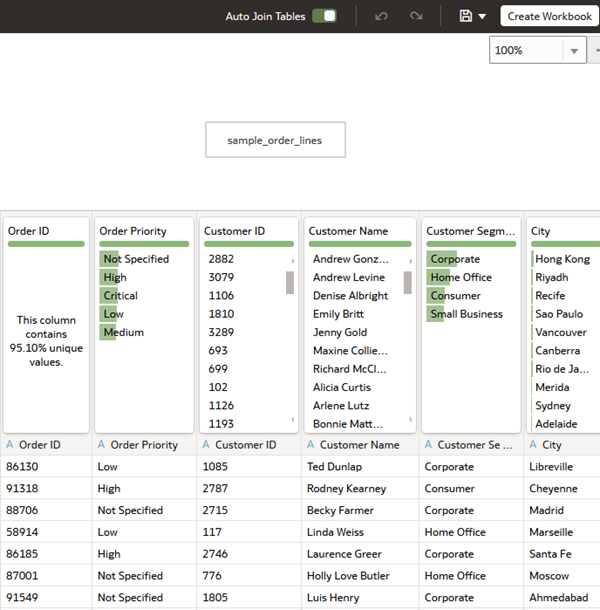
Description of the illustration sample_order_lines.png
Create a Top N Parameter
In this section, you create a Top Bottom N parameter in a workbook created from the sample_order_lines dataset.
- Click Create Workbook.
-
Click Parameters
 .
. - In the Parameters panel, click Add Parameter
 .
. - In Create Parameter, enter
Top Nin Name. - In the Data Type row, click Text, and select Integer as the value.
- In the Available Values list, select Any. In Initial Value list, select Value, enter
10in the value field, and then click OK.This example uses integer as the data type and 10 as the initial value.
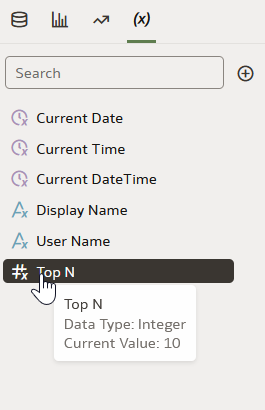
Description of the illustration topn_parameter.png
Create a Visualization
In this section, you create a visualization to use the Top Bottom N parameter as a filter.
- Click Data
 .
. - In the Data panel, hold down the CTRL key, select Sales and City. Right-click, select Pick Visualization, and then select Horizontal Stacked
 .
.

Description of the illustration horizontal_stacked.png - In the Sales by City visualization, click Menu
 , select Sort By, select Sales, and then select High to Low.
, select Sort By, select Sales, and then select High to Low.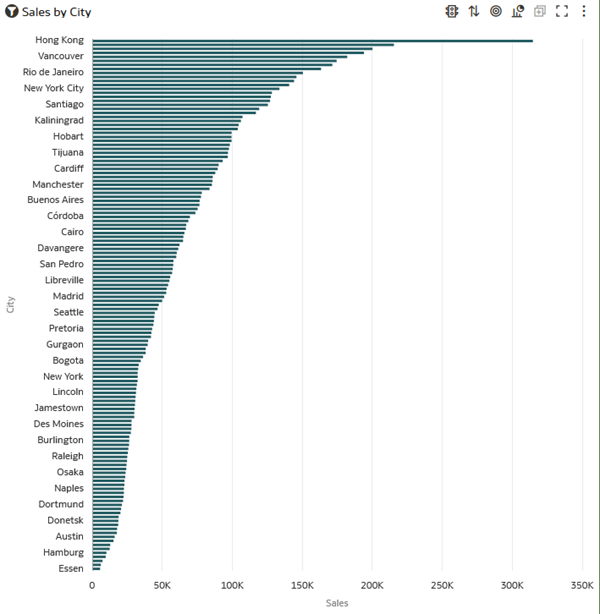
Description of the illustration sorted_viz.png - In the Data panel, select and drag City to Color.
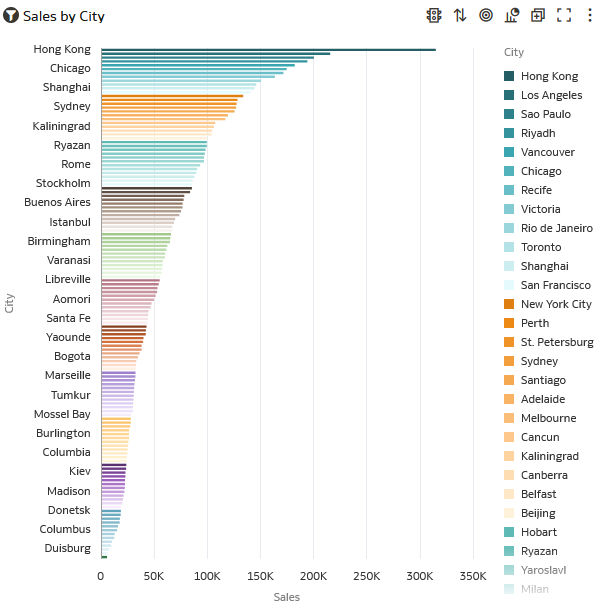
Description of the illustration sales_by_city_color.png
Connect the Parameter as a Filter
In this section, you create an expression filter with the Top N parameter.
- In the Grammar pane, hover over Filters click Drop Target Options, select Create Expression Filter.

Description of the illustration grammar_pane_filter.png - In Expression Filter, enter
Top Nin Label. - In the Expression, enter
Ran, select Rank. In the parentheses, click column and select Sales. Place your cursor outside of the closing parenthesis. - Click Show Available Functions
 , expand the Operator list, double-click less than or equal to (≤).
, expand the Operator list, double-click less than or equal to (≤). - Click Parameters
 . Drag the Top N parameter to the expression field. In default value, enter
. Drag the Top N parameter to the expression field. In default value, enter 10. - Click Validate. Click Apply.
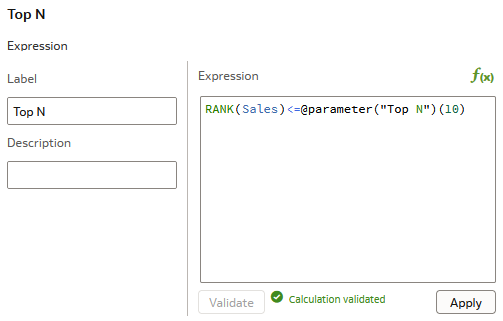
Description of the illustration topn_exp.png Oracle Analytics updates the visualization using the Top N expression filter.

Description of the illustration topn_viz.png
Expose the Top N Filter
In this section, you use the parameter in a dashboard filter.
- Click Visualizations
 . In the Visualization panel, select and drag Dashboard Filters
. In the Visualization panel, select and drag Dashboard Filters  to the canvas, and then release above the Sales by City visualization.
to the canvas, and then release above the Sales by City visualization. - Click Parameters
 .
. - Select and drag the Top N parameter to Filter Controls.
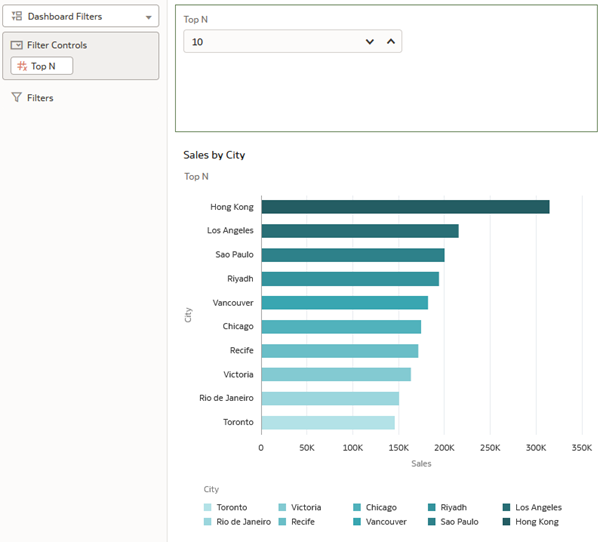
Description of the illustration topn_applied.png - Click Save. In Save Workbook, enter a Name, and then click Save.
Learn More
Create a Top Bottom N Parameter in Oracle Analytics
F79678-02
May 2024
Learn how to create a top bottom N parameter to use in a workbook in Oracle Analytics.
This software and related documentation are provided under a license agreement containing restrictions on use and disclosure and are protected by intellectual property laws. Except as expressly permitted in your license agreement or allowed by law, you may not use, copy, reproduce, translate, broadcast, modify, license, transmit, distribute, exhibit, perform, publish, or display any part, in any form, or by any means. Reverse engineering, disassembly, or decompilation of this software, unless required by law for interoperability, is prohibited.
If this is software or related documentation that is delivered to the U.S. Government or anyone licensing it on behalf of the U.S. Government, then the following notice is applicable:
U.S. GOVERNMENT END USERS: Oracle programs (including any operating system, integrated software, any programs embedded, installed or activated on delivered hardware, and modifications of such programs) and Oracle computer documentation or other Oracle data delivered to or accessed by U.S. Government end users are "commercial computer software" or "commercial computer software documentation" pursuant to the applicable Federal Acquisition Regulation and agency-specific supplemental regulations. As such, the use, reproduction, duplication, release, display, disclosure, modification, preparation of derivative works, and/or adaptation of i) Oracle programs (including any operating system, integrated software, any programs embedded, installed or activated on delivered hardware, and modifications of such programs), ii) Oracle computer documentation and/or iii) other Oracle data, is subject to the rights and limitations specified in the license contained in the applicable contract. The terms governing the U.S. Government's use of Oracle cloud services are defined by the applicable contract for such services. No other rights are granted to the U.S. Government.
This software or hardware is developed for general use in a variety of information management applications. It is not developed or intended for use in any inherently dangerous applications, including applications that may create a risk of personal injury. If you use this software or hardware in dangerous applications, then you shall be responsible to take all appropriate fail-safe, backup, redundancy, and other measures to ensure its safe use. Oracle Corporation and its affiliates disclaim any liability for any damages caused by use of this software or hardware in dangerous applications.
Oracle and Java are registered trademarks of Oracle and/or its affiliates. Other names may be trademarks of their respective owners.
Intel and Intel Inside are trademarks or registered trademarks of Intel Corporation. All SPARC trademarks are used under license and are trademarks or registered trademarks of SPARC International, Inc. AMD, Epyc, and the AMD logo are trademarks or registered trademarks of Advanced Micro Devices. UNIX is a registered trademark of The Open Group.
This software or hardware and documentation may provide access to or information about content, products, and services from third parties. Oracle Corporation and its affiliates are not responsible for and expressly disclaim all warranties of any kind with respect to third-party content, products, and services unless otherwise set forth in an applicable agreement between you and Oracle. Oracle Corporation and its affiliates will not be responsible for any loss, costs, or damages incurred due to your access to or use of third-party content, products, or services, except as set forth in an applicable agreement between you and Oracle.